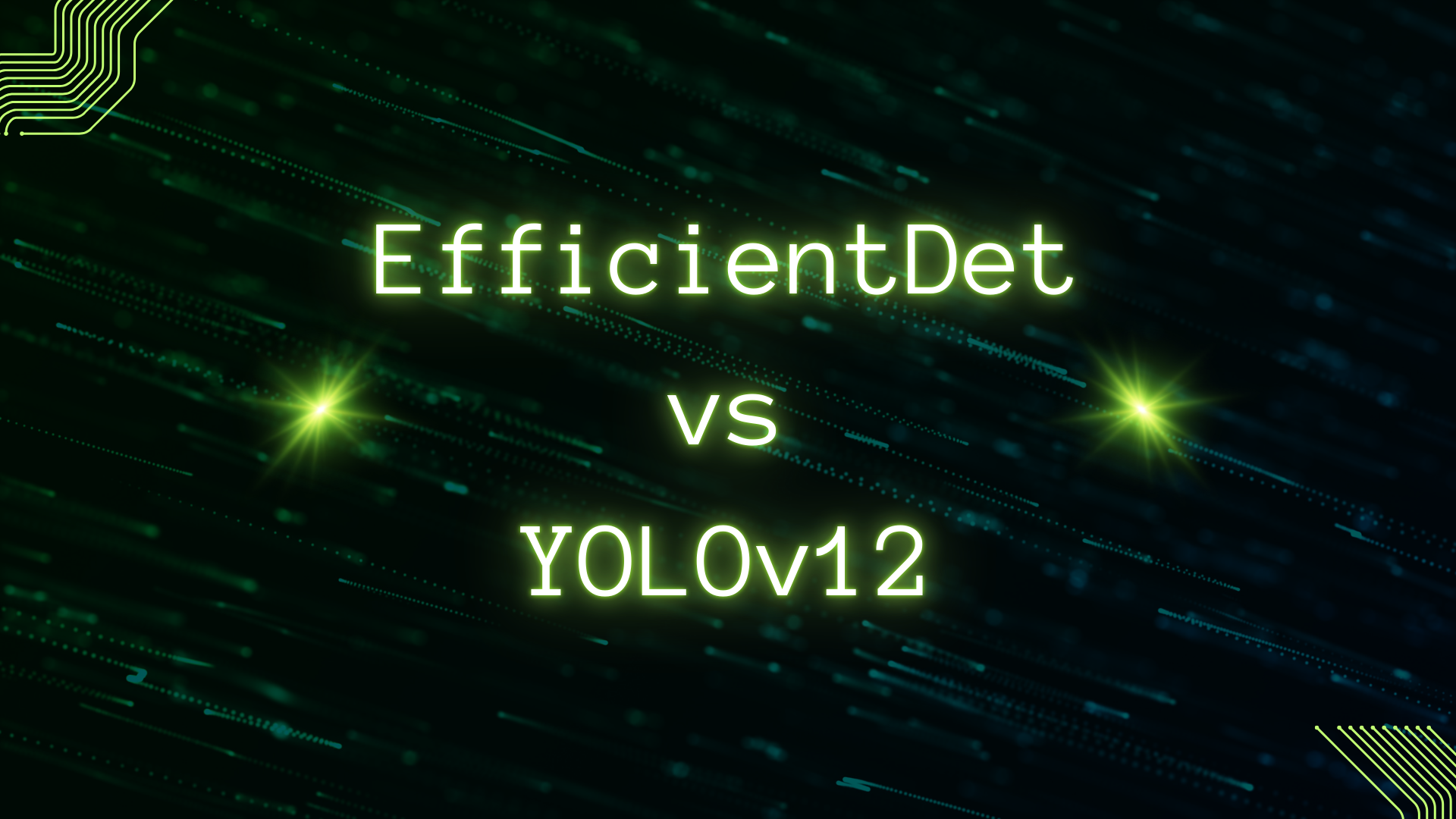EfficientDet vs YOLOv12: Which Object Detection Model Is Best for Your Needs?

Object detection is a foundational task in computer vision, underpinning numerous applications, including surveillance, autonomous navigation, and industrial automation. Two preeminent models in this domain are EfficientDet and YOLOv12.
EfficientDet, predicated on the EfficientNet backbone, is renowned for its computational efficiency and robust accuracy. Conversely, YOLOv12, a progression of the YOLO (You Only Look Once) framework, is distinguished by its real-time inference capability and architectural flexibility.
This article presents a rigorous comparative analysis of these models, emphasizing their structural composition, empirical performance, algorithmic distinctions, and contextual applicability.
Introduction to Object Detection
Object detection entails the simultaneous localization and classification of entities within visual data. This dual-task paradigm necessitates a model architecture capable of balancing precision and computational efficiency. As deep learning methodologies have evolved, several object detection frameworks have emerged, each exhibiting unique architectural innovations and trade-offs.
EfficientDet: Architectural Innovations and Performance
Core Architectural Components
EfficientDet, introduced by Google Brain in 2020, exemplifies state-of-the-art object detection through an optimized network design that mitigates computational overhead while sustaining high accuracy. The model capitalizes on the EfficientNet backbone and incorporates a Bidirectional Feature Pyramid Network (BiFPN) to enhance multi-scale feature representation.
Salient Architectural Features:
- EfficientNet Backbone: Implements a compound scaling strategy to optimize network depth, width, and resolution cohesively.
- BiFPN (Bidirectional Feature Pyramid Network): Facilitates enhanced multi-scale feature fusion via a weighted summation mechanism.
- Weighted BiFPN: Dynamically assigns significance to feature maps of varying resolutions, augmenting detection efficacy across diverse object scales.
Empirical Performance and Computational Efficiency
The EfficientDet model family (ranging from EfficientDet-D0 to EfficientDet-D7) offers a spectrum of trade-offs between inference speed and accuracy. Empirical evaluations highlight its superior efficiency in achieving state-of-the-art detection accuracy with reduced computational complexity.
Key Advantages:
- Optimized Accuracy: Attains benchmark-leading performance in object detection tasks.
- Computational Efficiency: Requires fewer parameters and FLOPs compared to conventional detection frameworks.
- Scalability: Offers adaptable model configurations to cater to diverse deployment environments.
YOLOv12: Real-Time Performance and Architectural Flexibility
Structural Overview and Innovations
YOLOv12 is a prospective iteration in the YOLO series, which has historically prioritized real-time object detection. While specific architectural details remain speculative, the evolutionary trajectory of YOLO suggests a continual refinement of its anchor-free detection mechanism, backbone modularity, and composite loss optimization.
Characteristic Features:
- Anchor-Free Detection Paradigm: Enhances generalization and mitigates computational burden.
- Versatile Backbone Support: Likely to incorporate CSPDarknet or other adaptive architectures.
- Real-Time Optimization: Engineered for minimal latency, ensuring feasibility for high-speed applications.
Performance and Functional Merits
As inferred from prior YOLO iterations, YOLOv12 is expected to maintain a delicate balance between inference speed and detection accuracy. It is well-suited for latency-sensitive applications where rapid decision-making is imperative.
Key Advantages:
- Expedited Inference: Optimized for real-time object detection scenarios.
- Multi-Purpose Utility: Extends beyond object detection to facilitate instance segmentation and classification.
- User-Centric Implementation: Benefits from robust documentation and developer support via Ultralytics.
Comparative Analysis of EfficientDet and YOLOv12
Architectural Distinctions
| Feature | EfficientDet | YOLOv12 (Hypothetical) |
|---|---|---|
| Backbone | EfficientNet | CSPDarknet (likely) |
| Detection Approach | Anchor-based with BiFPN | Anchor-free |
| Loss Function | Standard object detection losses | Composite loss functions (e.g., CIoU, Focal Loss) |
Performance Metrics
| Model | Accuracy (AP) | Inference Speed | Model Size |
|---|---|---|---|
| EfficientDet-D4 | 49.7% | 33.55 ms | 55.2 MB |
| YOLOv8 (proxy for YOLOv12) | High accuracy, real-time speed | Varies by variant | Varies by variant |
Suitability for Application-Specific Scenarios
| Use Case | EfficientDet | YOLOv12 |
|---|---|---|
| Real-Time Video Processing | Less optimized for real-time scenarios | Ideal due to low-latency inference |
| Industrial Automation | Suitable for controlled environments | Adaptable across dynamic contexts |
| Autonomous Systems | High detection accuracy but computationally intensive | Optimal for rapid decision-making |
Algorithmic Implementation: Coding Differences
A crucial distinction between EfficientDet and YOLO lies in their implementation ecosystems. EfficientDet is primarily integrated within TensorFlow, whereas YOLO models are predominantly implemented using PyTorch.
EfficientDet Implementation in TensorFlow
import tensorflow as tf
import tensorflow_hub as hub
# Load EfficientDet model
detector = hub.load("https://tfhub.dev/tensorflow/efficientdet/d4/1")
# Object detection function
def detect_objects(image):
return detector(image)
YOLOv12 Implementation in PyTorch (Hypothetical)
from ultralytics import YOLO
# Load YOLOv12 model
model = YOLO("yolov12.pt")
# Perform inference on an image
results = model("image.jpg")
results.show()
Prospective Challenges and Future Research Directions
Despite their strengths, both EfficientDet and YOLO face intrinsic limitations. EfficientDet's high accuracy is often accompanied by increased computational demand, rendering it suboptimal for real-time applications. Conversely, YOLO's real-time capability may compromise detection precision under complex conditions.
Future Research Considerations:
- Hybrid Model Architectures: Investigating synergistic integrations of EfficientDet’s precision with YOLO’s computational efficiency.
- Efficient Training Paradigms: Developing training strategies that optimize resource utilization without compromising model performance.
- Automated Model Compression Techniques: Implementing pruning and quantization strategies to enhance deployment feasibility.
Conclusion
EfficientDet and YOLOv12 epitomize two distinct paradigms in object detection: accuracy-centric efficiency versus real-time adaptability. The selection of an appropriate model is contingent on domain-specific requirements, encompassing computational constraints, accuracy thresholds, and latency tolerances.
As research in deep learning progresses, hybrid approaches may emerge, integrating the robustness of EfficientDet with the speed of YOLO, thereby redefining the landscape of object detection methodologies.